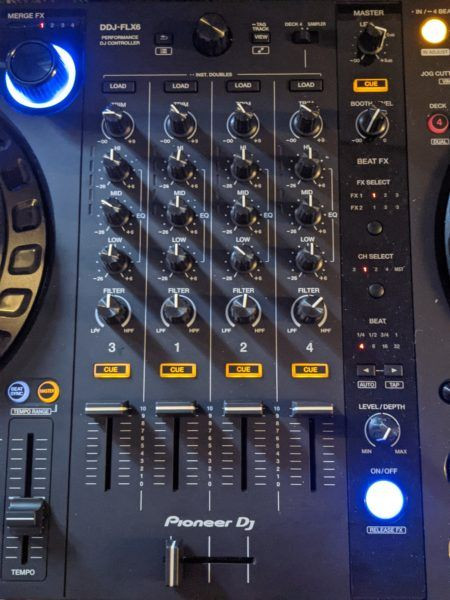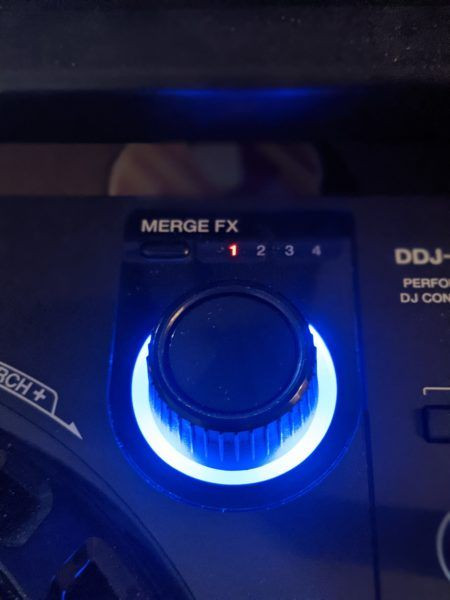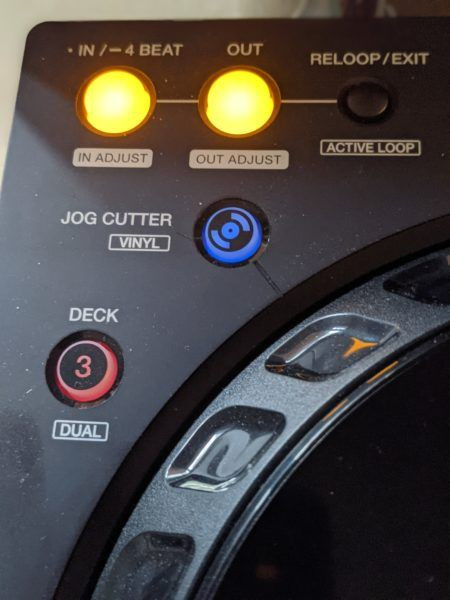Pioneer DJ truly surprised the DJ community with the unveiling of the DDJ-FLX6, a competitively priced $599 DJ controller that boasts compatibility with both Serato and Rekordbox software. The DDJ-FLX6 emerges as an intriguing hybrid, seemingly drawing inspiration from both the professional-grade DDJ-1000 and the entry-level DDJ-400. It offers desirable features like four channels and full-sized jog wheels, achieving this by making strategic compromises in build quality and connectivity options, positioning itself uniquely in the DJ controller market.
Addressing the Mid-Range Controller Conundrum
For DJs operating in home setups, the controller market has often presented a challenging scenario. The significant jump in price, often exceeding $1,000, to access controllers with substantial feature upgrades from entry-level models like the DDJ-400 (in the $200-$300 range) has long felt disproportionate. Existing mid-range controllers, such as the DDJ-SR2 and DDJ-800, have traditionally prioritized robust build quality and enhanced connectivity over groundbreaking performance features. These models often mirror the layouts of their entry-level counterparts, focusing on improved durability and expanded input/output options rather than revolutionizing the DJing experience.
The Pioneer DDJ-FLX6 appears to be Pioneer DJ’s direct response to this gap in the market. It’s designed as a mid-range controller that places performance features at the forefront. Unlike controllers like the SR2 which emphasize a standalone mixer section and metal-reinforced construction, the FLX6 prioritizes functionality by offering four channels and full-size jog wheels. These are features typically reserved for Pioneer DJ’s higher-end, more expensive equipment, making the FLX6 a compelling option for DJs seeking professional-level features without the premium price tag.
Dual Software Compatibility: A Welcome Shift
The inclusion of dual Rekordbox and Serato compatibility is a genuinely surprising and welcome development. For over a decade, the DJ controller industry has been plagued by the frustrating trend of exclusive software support, forcing DJs to choose ecosystems and limiting flexibility. Seeing software giants like Serato and Rekordbox collaborate on hardware compatibility is a refreshing and positive step forward for the DJ community.
However, it’s important to note that the DDJ-FLX6, while compatible with both, is fundamentally designed as a Rekordbox controller. The Serato DJ integration, while functional, isn’t as deeply integrated. There’s a lack of full MIDI mapping capabilities and reduced customization options for features like the innovative Merge FX. Despite this, in practical use, the unit felt remarkably responsive with Serato DJ. This responsiveness might be attributed to Serato DJ’s historical optimization as a streamlined program, initially designed for the fast-paced demands of turntablism.
Input/Output (I/O) Connectivity: Home Studio Focus
The I/O configuration of the Pioneer DDJ-FLX6 clearly signals its intended market: the home DJ and bedroom producer. Connectivity is streamlined, featuring a single pair of RCA master outputs, a second pair of RCA booth outputs, and a single ¼ inch microphone jack equipped with attenuator control. A key limitation for some users is the microphone input’s lack of soundcard connectivity. This means microphone audio is not directly routed to software for recording or livestreaming purposes.
For DJs looking to livestream their sets using the FLX-6, a workaround is necessary. Connecting the controller to an external audio interface, such as an iRig Stream or a Focusrite Scarlett 2i2, allows for routing audio to a computer for streaming or recording. While not a direct solution, it provides a viable path for online broadcasting.
On a more positive note, the front panel thoughtfully includes both ¼ inch and 3.5mm headphone jacks. This eliminates the need for potentially fragile adapters when using professional-grade headphones, a small but significant convenience for DJs.
The absence of balanced XLR or ¼ inch outputs is a notable drawback, particularly for DJs performing in professional venues. PA systems in clubs and larger spaces typically rely on the enhanced signal stability offered by balanced outputs. While this limitation might deter some professional DJs, it can be addressed by incorporating an external soundcard or a portable live mixer into the setup.
Jog Wheels: CDJ-Inspired Performance
The standout feature of the Pioneer DDJ-FLX6 is undoubtedly its pair of 7-inch capacitive jog wheels. Despite utilizing capacitive technology, these jog wheels are designed to emulate the feel of Pioneer DJ’s renowned CDJ players. They offer a weighted, tactile response with a satisfying level of rotational noise, closely mimicking the experience of using professional CDJ jog wheels. The inclusion of center on-jog displays is a welcome premium touch. These displays provide essential visual feedback, showing needle position and other relevant information such as slip mode status, enhancing the DJing workflow.
 Pioneer DDJ-FLX6 Mixer Section
Pioneer DDJ-FLX6 Mixer Section
Mixer, Effects, and Crossfader: Navigating the Controls
The four-channel mixer section on the DDJ-FLX6 is a significant advantage, enabling DJs to easily manage and mix up to four decks simultaneously. This opens up a wider range of creative possibilities compared to many competing mid-range controllers that are limited to two channels. The mixer knobs are constructed from plastic and mounted on robust plastic potentiometers, providing a reassuringly sturdy feel during use. However, the crossfader presents a notable point of concern. It exhibits an unusual stiffness and suffers from resolution issues. This stiffness and lack of precision can be problematic for scratch DJs, as techniques like crab and transformer scratches become noticeably more challenging to execute accurately.
The effects section on the right-hand side of the Pioneer DDJ-FLX6 draws clear inspiration from Pioneer DJ’s professional DJM mixer line. It features a single button for cycling through the six available effects slots within Serato and Rekordbox’s FX banks, which are user-customizable. Another button allows for toggling between channel assignments, offering options for Channels 1-4 and Master output. Effect parameters are controlled via a level/depth knob, beat value buttons, and a simple on/off button. Red LEDs provide clear visual feedback, indicating the currently selected effect and channel assignment.
Deck Controls and Performance Pads: Essential Tools at Your Fingertips
Beyond the fundamental play and cue buttons, the DDJ-FLX6 offers a solid array of deck controls positioned alongside its performance pads. The performance pads themselves are constructed from a clicky rubber material, similar in feel to those found on the DDJ-SB3. They are unicolor and non-RGB, a cost-saving measure that may be noticeable for users accustomed to more visually dynamic RGB pads.
Interestingly, unlike other Rekordbox controllers, the pad modes on the FLX-6 are not editable within the Rekordbox software. The tempo faders are identical to those found on the DDJ-400, offering a decent length for pitch adjustments but with somewhat limited resolution. Sync and master tempo buttons are conveniently located above the fader for easy access during performance.
 Pioneer DDJ-FLX6 Performance Pads
Pioneer DDJ-FLX6 Performance Pads
A notable omission is the lack of dedicated slip mode or reverse buttons. Despite this, the Pioneer DDJ-FLX6 introduces several innovative features not previously seen on Pioneer controllers, namely Jog Cutter and Merge FX, which warrant closer examination.
Innovative Performance Features: Pushing Creative Boundaries
Merge FX: Instant Buildups and Transitions
 Pioneer DDJ-FLX6 Merge FX Feature
Pioneer DDJ-FLX6 Merge FX Feature
The DDJ-FLX6 boasts a set of prominent Merge FX encoders, representing a significant new performance feature. Merge FX appears to function as a type of “safety net” or creative tool for generating instant effect buildups. When activated and rotated, Merge FX creates dramatic, layered effect combinations. Upon “dropping” or deactivating the effect, it effectively cuts out the currently playing track, paving the way for seamless transitions to another track. While potentially useful for EDM DJs and as a recovery tool for mixing errors, the intensity and somewhat pre-programmed nature of Merge FX might sound overly aggressive for more nuanced genres like house music.
Jog Cutter: Scratching Made Easy (or Haphazard?)
 Pioneer DDJ-FLX6 Jog Cutter Feature
Pioneer DDJ-FLX6 Jog Cutter Feature
Another novel feature is the “Jog Cutter” mode. This mode allows DJs to create complex stutter-scratch patterns simply by manipulating the jog wheel in a somewhat haphazard manner. Different sections of the jog wheel trigger distinct pre-programmed scratch patterns. While Jog Cutter might find niche applications, the pre-set patterns can sound somewhat rigid and predictable. Many DJs, particularly those with scratching experience, may prefer the greater control and expressiveness of creating similar fills manually.
Dual-Deck Control: Layering and Expanding Performance
The DDJ-FLX6 also introduces Dual-Deck Mode, a control that links the controls of one deck to simultaneously manipulate two layers (e.g., the left deck controls tracks A and C concurrently). This opens up exciting new performance possibilities, such as layering an acapella and instrumental on separate decks but controlling them as a unified track, allowing for on-the-fly remixing and creative track manipulation.
Sample Scratch: Scratching Beyond Tracks
Perhaps the most groundbreaking feature of the DDJ-FLX6 is Sample Scratch mode, a feature first seen on the high-end DJM-S11 mixer. Sample scratch allows samples to be loaded directly to the jog wheel and scratched without needing to dedicate an entire deck to sample playback. This is a much-needed solution for scratch DJs who previously had to load tracks filled with scratch samples and navigate them using hot cues, streamlining the workflow for sample-based scratching.
Conclusion: Feature-Rich and Wallet-Friendly
Pioneer DJ’s DDJ-FLX6 firmly positions itself as a bedroom-focused controller that prioritizes performance features and accessibility. With its full-sized jog wheels, four channels, and a collection of new performance tools (some more intuitive than others), the FLX6 is a highly attractive option for hobbyist DJs seeking advanced features without a prohibitive price tag. The inclusion of both Serato and Rekordbox compatibility further broadens its appeal.
It’s highly likely that the DDJ-FLX6 will be a popular choice among home DJs who have long desired an affordable four-channel controller with professional-feeling large jog wheels. While some of the new features might be perceived as gimmicky by seasoned professional DJs, hobbyist DJs who prioritize fun and spontaneous creativity will likely embrace the feature-laden nature of the controller.
For the professional DJ market, a potential Mk2 version with balanced outputs would be necessary to make the FLX series a viable option for club and professional performance environments. Nevertheless, the DDJ-FLX6 has successfully carved out a unique niche in the DJ market, offering a compelling blend of features and affordability that is poised to resonate strongly with budget-conscious hobbyist DJs.
The Pioneer DDJ-FLX6 is priced at $599 and is available for purchase at the DJ TechTools shop here.
